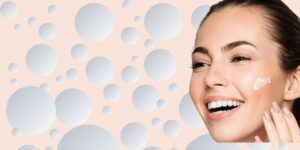Introduction
Vitamin E is a broad term used to refer to a family of eight powerful antioxidants. This family can be further broken down into 2 groups of 4 members, being the tocopherols and the tocotrienols. Alpha tocopherol (α-tocopherol) is one of the most scientifically researched and tested of these skincare ingredients. Because it is the skin’s main oil-soluble anti-oxidant vitamin, it plays a critical role in protecting the skin against UV radiation damage1. As UV radiation damage to skin collagen is one of the main causes of skin aging, Vitamin E plays an important role in countering this skin aging process. However, it plays other important roles in protecting, repairing and promoting healthy looking skin.
“The anti-oxidant α-tocopherol is highly important because it can stop ongoing lipid peroxidation, by the reduction of the lipid peroxyl radical to hydroperoxide2.”
Benefits for Your Skin
Vitamin E plays a special and critical role in our skin’s environmental protection and health. It has been thoroughly researched in a many reputable academic journals and the following skincare benefits are reported:
“The induction and regulation of endogenous antioxidant defense mechanisms may offer a good strategy for the treatment and prevention of aging and photoaging in human skin.”3
1. Antioxidant Protection and Skin Repair
It has been shown that Vitamin E (α-tocopherol) significantly decreases the ultraviolet radiation-induced radical flux in skin, reducing skin damage caused by UV radiation1. Vitamin E protects skin tissues against UV-induced oxidative damage4. The results of another study suggest that DNA photoprotection is an important mechanism by which topically applied α-tocopherol can inhibit UVB induced skin cancer5.
With exposure to UV radiation and ozone, Vitamin E in the stratum corneum has shown to be depleted in protecting the skin from the oxidative effects of UV radiation6 and ozone7. Topical application of Vitamin E is therefore an effective way to protect the skin against the aging effects of UV radiation and ozone.
“These results demonstrate that topical administration of alpha-tocopherol protects cutaneous tissues against oxidative damage induced by UV irradiation.”4
2. Enhanced Action in Combination with Vitamin C
As Vitamin E is our skin’s main oil soluble anti-oxidant, it helps protect skin lipids and proteins from environmental oxidative damage. Vitamin E is depleted by the action of UV radiation7. Vitamin C regenerates Vitamin E after it completes it’s skin-protective, oxidative action8. Because Vitamin C can regenerate Vitamin E, it greatly enhances the oxidative and protective capacity of the skin9. Antioxidants do not work individually in the skin but work synergistically in an integrated and regulated way to protect against oxidative stress9.
Because combined anti-oxidant treatments provides greater skin protection than single treatments, it is preferable to use skincare treatments containing anti-oxidant combinations9.
3. Important Choice of Formulation
Studies have shown that microemulsions provide suitable formulations for effectively and stably combining water soluble (Vitamin C) and oil soluble (Vitamin E) ingredients10,11. Encapsulation of Vitamin E in nano-structures combined with Vitamin C and colloidal silica improved skin delivery of both Vitamin E and Vitamin C12. Using these structures increased the solubility of both vitamins and resulted in much higher levels of skin penetration12 and effective action.
4. Skin Collagen Repair and Replacement
Microemulsions loaded with Vitamin E and Vitamin C have been shown to increase penetration of both vitamins and increase collagen deposition12.
5. Anti-inflammatory Action
Vitamin E acts as an anti-inflammatory agent and affects the remodeling of scars by interacting with the phospholipids in cell membranes, inducing molecular packing and maintaining the stability of biologic membranes13.
6. Scar Treatment
The general consensus about the application of a vitamin E-based cream or emollient is that it would lead to beneficial scar healing13.
7. Generally Regarded as Safe
Vitamin E and its many derivatives have been extensively studied and are generally regarded as safe, non-irritating skincare ingredients14 .
Discussion
“Cutaneous application of vitamin E ameliorates photoaging, decreases lipid peroxidation and furthermore also reduces photocarcinogenesis, MMP-1 transcription levels and thymine dimer formation.”15
Vitamin E is the most important oil soluble antioxidant in protecting skin tissues. It is the skin’s first line of defence against UV and ozone induced damage to skin collagen and skin lipids. As such it is an important component in the fight against skin aging. Topical application is the best method to increase skin levels of protective Vitamin E. Formulations combining both Vitamin E and Vitamin C provide enhanced action and penetration and have proved to be far more effective in protecting the skin.
References
- 1.Jurkiewicz B, Bissett D, Buettner G. Effect of topically applied tocopherol on ultraviolet radiation-mediated free radical damage in skin. J Invest Dermatol. 1995;104(4):484-488. doi:10.1111/1523-1747.ep12605921
- 2.Rinnerthaler M, Bischof J, Streubel M, Trost A, Richter K. Oxidative stress in aging human skin. Biomolecules. 2015;5(2):545-589. doi:10.3390/biom5020545
- 3.Rhie G, Shin M, Seo J, et al. Aging- and photoaging-dependent changes of enzymic and nonenzymic antioxidants in the epidermis and dermis of human skin in vivo. J Invest Dermatol. 2001;117(5):1212-1217. doi:10.1046/j.0022-202x.2001.01469.x
- 4.Lopez-Torres M, Thiele J, Shindo Y, Han D, Packer L. Topical application of alpha-tocopherol modulates the antioxidant network and diminishes ultraviolet-induced oxidative damage in murine skin. Br J Dermatol. 1998;138(2):207-215. doi:10.1046/j.1365-2133.1998.02062.x
- 5.McVean M, Liebler D. Inhibition of UVB induced DNA photodamage in mouse epidermis by topically applied alpha-tocopherol. Carcinogenesis. 1997;18(8):1617-1622. doi:10.1093/carcin/18.8.1617
- 6.Thiele J, Traber M, Packer L. Depletion of human stratum corneum vitamin E: an early and sensitive in vivo marker of UV induced photo-oxidation. J Invest Dermatol. 1998;110(5):756-761. doi:10.1046/j.1523-1747.1998.00169.x
- 7.Thiele J, Traber M, Polefka T, Cross C, Packer L. Ozone-exposure depletes vitamin E and induces lipid peroxidation in murine stratum corneum. J Invest Dermatol. 1997;108(5):753-757. doi:10.1111/1523-1747.ep12292144
- 8.Burke K. Interaction of vitamins C and E as better cosmeceuticals. Dermatol Ther. 2007;20(5):314-321. doi:10.1111/j.1529-8019.2007.00145.x
- 9.Lin J, Selim M, Shea C, et al. UV photoprotection by combination topical antioxidants vitamin C and vitamin E. J Am Acad Dermatol. 2003;48(6):866-874. doi:10.1067/mjd.2003.425
- 10.Rozman B, Gasperlin M, Tinois-Tessoneaud E, Pirot F, Falson F. Simultaneous absorption of vitamins C and E from topical microemulsions using reconstructed human epidermis as a skin model. Eur J Pharm Biopharm. 2009;72(1):69-75. doi:10.1016/j.ejpb.2008.10.004
- 11.Rozman B, Gosenca M, Gasperlin M, Padois K, Falson F. Dual influence of colloidal silica on skin deposition of vitamins C and E simultaneously incorporated in topical microemulsions. Drug Dev Ind Pharm. 2010;36(7):852-860. doi:10.3109/03639040903541187
- 12.Aljuffali I, Hsu C, Lin Y, Fang J. Cutaneous delivery of natural antioxidants: the enhancement approaches. Curr Pharm Des. 2015;21(20):2745-2757. doi:10.2174/1381612821666150428125428
- 13.Tanaydin V, Conings J, Malyar M, van der, van der. The Role of Topical Vitamin E in Scar Management: A Systematic Review. Aesthet Surg J. 2016;36(8):959-965. doi:10.1093/asj/sjw046
- 14.Zondlo F. Final report on the safety assessment of Tocopherol, Tocopheryl Acetate, Tocopheryl Linoleate, Tocopheryl Linoleate/Oleate, Tocopheryl Nicotinate, Tocopheryl Succinate, Dioleyl Tocopheryl Methylsilanol, Potassium Ascorbyl Tocopheryl Phosphate, and Tocophersolan. Int J Toxicol. 2002;21 Suppl 3:51-116. doi:10.1080/10915810290169819
- 15.Chen L, Hu J, Wang S. The role of antioxidants in photoprotection: a critical review. J Am Acad Dermatol. 2012;67(5):1013-1024. doi:10.1016/j.jaad.2012.02.009












